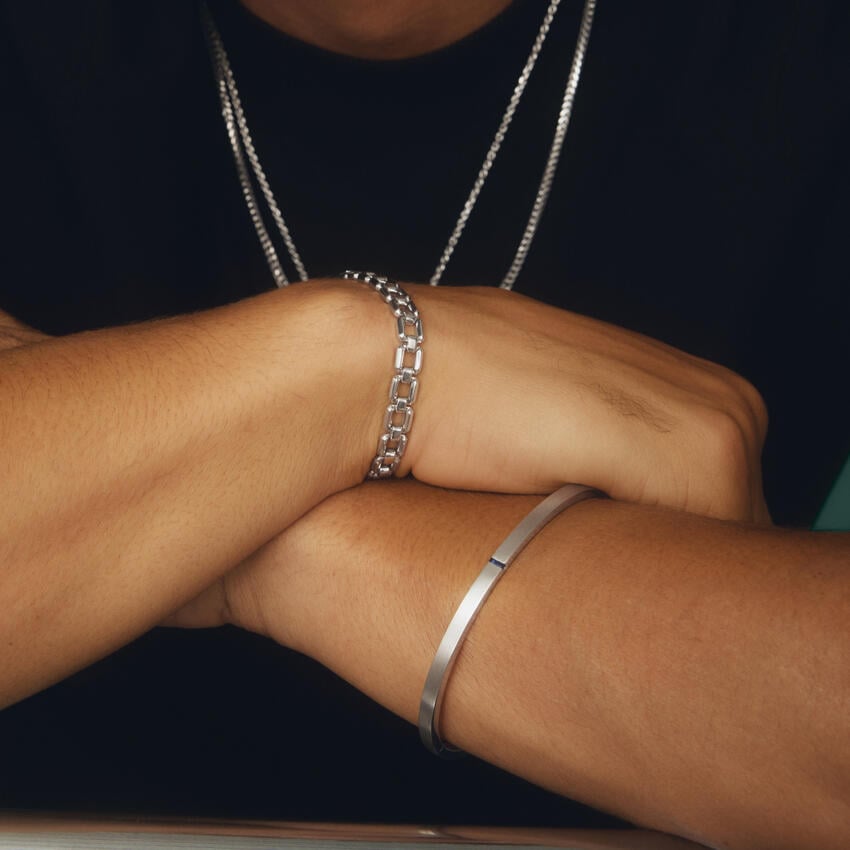Patina is a transformation that occurs on metal jewelry, creating a distinctive surface finish through either natural oxidation or controlled chemical processes. Unlike simple tarnish, patina manifests as an array of color variations and textural changes that can enhance a piece’s beauty and character. This surface evolution ranges from subtle shifts in platinum’s sheen to dramatic color developments in silver, making each piece uniquely beautiful as it ages.
Patina Meaning
The term “patina” in jewelry refers to a controlled oxidation layer that develops on metal surfaces, either through natural aging or intentional treatment. This sophisticated surface modification can appear as subtle shifts in color, changes to texture, or both, creating a finish that tells the story of the metal’s journey through time. Ancient metalworkers first recognized patina’s aesthetic value, noticing how certain metals developed appealing characteristics with age. Today, this natural aging process is often celebrated in both antique and contemporary jewelry design.
Patina vs. Tarnish
Though frequently confused, patina and tarnish represent distinctly different processes in jewelry aging. Tarnish appears as an unwanted, dull discoloration caused by uncontrolled chemical reactions between metal and environmental elements. Patina, by contrast, describes a controlled and often desirable transformation that adds depth and character to jewelry. While tarnish typically requires removal to restore a piece’s beauty, patina often enhances it, creating a sophisticated finish that many wearers actively seek.
How Does Patina Affect Jewelry?
Environmental conditions profoundly influence patina development, with factors like humidity, air quality, and temperature playing crucial roles in how this surface transformation evolves. Coastal environments, rich in salty air, often accelerate patina formation, while drier climates may slow this natural process. Modern jewelry designers increasingly embrace patina’s potential, deliberately selecting metals and finishes that will develop character over time. This evolution adds depth to surface appearance and often highlights intricate design elements that might otherwise go unnoticed, making patina an integral part of contemporary jewelry aesthetics.
Platinum Patina
Platinum jewelry develops a unique “wear patina” – a sophisticated transformation of its initially bright surface into a soft, matte finish that many collectors covet. Unlike other metals’ patina, platinum’s surface change comes from micro-scratches and everyday wear rather than oxidation. This natural evolution doesn’t alter the metal’s fundamental color but creates a luxurious, lived-in appearance that many think enhances platinum’s inherent beauty. The change becomes most evident when comparing a patinated piece to newly polished platinum, though the transformation occurs so gradually that wearers often don’t notice it developing. This type of patina can be either maintained for character or polished away for a renewed brightness, offering versatility in how the piece is worn.
Gold Patina
While pure gold remains stable against patination, gold alloys exhibit intriguing surface changes that enhance their aesthetic appeal over time. The development of patina in gold jewelry varies significantly based on the alloy composition. For example, 14k and 18k gold pieces may show subtle variations in their surface appearance through extended wear, particularly in detailed areas. Rose gold presents the most dramatic transformation due to its copper content, often developing deeper, richer tones that many enthusiasts seek. White gold typically resists obvious patina development due to its rhodium plating, though the underlying metal may show subtle changes once this protective layer wears away.
Silver Patina
Among precious metals, silver exhibits the most dramatic and diverse patina development, making it particularly interesting for wearers and designers. When exposed to environmental elements, silver jewelry undergoes a natural oxidation process that creates a spectacular range of colors, from subtle golden hues to deep, rich blacks. This transformation begins in recessed areas, naturally highlighting intricate design elements and creating striking visual contrast. Professional jewelers often accelerate and control this process through specific chemical treatments to achieve desired aesthetic effects. Whether developing naturally over months or years or created intentionally, each silver piece’s patina tells a unique story through its distinctive pattern of color and texture.
Is Patina on Jewelry Bad?
Patina’s desirability depends entirely on context and personal preference rather than any inherent “good” or “bad” quality. For antique and vintage pieces, natural patina often adds significant value by authenticating age and enhancing character. To identify patina on your jewelry, examine pieces under good lighting, and look for uneven coloring in recessed areas, uniform softening of bright finishes, or subtle color variations from the original metal tone. Professional jewelers can help determine whether surface changes represent desirable patina or unwanted tarnish requiring attention. Many collectors and experts actively seek pieces with well-developed patina, viewing it as both a protective layer and a testament to the jewelry’s history.
How to Remove Patina on Jewelry
When removal of patina is desired, the process requires careful attention to the specific metal type and patina characteristics. Professional jewelers recommend beginning with the gentlest possible cleaning methods before progressing to more intensive techniques. For silver, specialized silver polishing cloths can effectively remove light patina while preserving the metal’s integrity. Platinum and gold alloys typically respond well to gentle cleaning solutions specifically formulated for precious metals. Importantly, harsh chemical cleaners should be avoided as they can permanently damage the metal’s surface or create uneven coloring. For valuable or antique pieces, professional cleaning is recommended to ensure proper preservation of the jewelry’s character while achieving the desired finish.
How to Maintain Patina on Jewelry
Preserving a desirable patina requires thoughtful attention to environmental factors and wearing conditions. Store patinated pieces in tarnish-resistant bags or boxes with anti-tarnish strips to maintain stable conditions. Avoid exposing jewelry to household chemicals, perfumes, cosmetics, and personal care products that can alter patina development. Remove jewelry before swimming, bathing, or engaging in activities involving chemicals, as chlorine and other substances can dramatically affect patina appearance. Regular maintenance should include gentle cleaning with a soft, dry cloth to remove surface oils and dirt without disturbing the patinated finish. Professional jewelers can apply protective sealants to preserve particularly desirable patinas, though this should be discussed with a professional jeweler to ensure compatibility with your piece.







